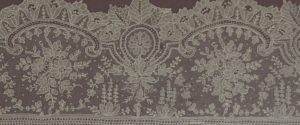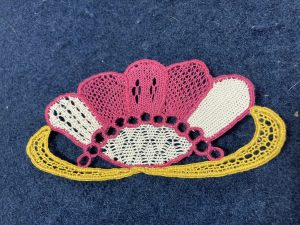
- Category: Arzhela
- Published: 20 January, 2023
Hello everybody!
In a month we will have the third needle lace course with Rosa Ocana in Valladolid.
Needle lace used to be made on parchment, nowadays it is made on paper, where the lace design is traced. The lace-maker places threads on the outlines of the design and sews them together to hold them in place. These threads serve as a support for working the lace on the parchment. From there, the petals and leaves of the design are filled in and then joined together to make the background (definition by Auguste Lefébure, Dentelle et Guipure, 1902 edition).
We are talking about a very laborious lace. In Alençon (France), where there is a national workshop, where the lace-makers maintain this technique next to a lace museum, they tell us that it takes 7 hours for each square centimetre of lace.
The lace-makers never made a whole piece. Many lace-makers worked on each piece, each in a different phase of the needle lace making process. Few lace makers knew all the secrets of this marvellous technique.
All theories say that needle lace is a descendant of cut-thread embroidery. Venice seems to be the first city where its manufacture was organised and it became an important industry in the Renaissance.
Needle lace is usually worked in white. Needle lace can be found in Alençon and Argentan in France, in Brussels (point de gaze) and in Italy (mainly Venice and Burano).
In Spain, we find a specific needle lace, called Frisado de Valladolid. This technique, within the needle lace, adds very characteristic rings and was worked with gold and silver threads. This meant that only the ladies of the court and the nuns of the convents made these laces, and production was therefore quite scarce.
As a result, few examples of these ancient laces remain today, and some of them are found in cloistered convents, so we do not have access to them (as in Toledo, for example). In Medina del Campo, in the Museo Teresiano de San José, we can also see an example of this marvel.
With Rosa we would like to be able to do this technique but for the moment we are just taking the first steps in this laborious technique. Here is a photo of my first work, modest, with its faults. But I am very happy to discover something new and so exciting and different from the bobbin lace I usually do.
Cheer up! Rosa teaches you!
 |
 |
 |
Share with your special people


